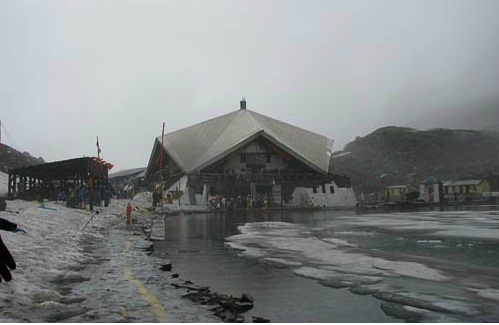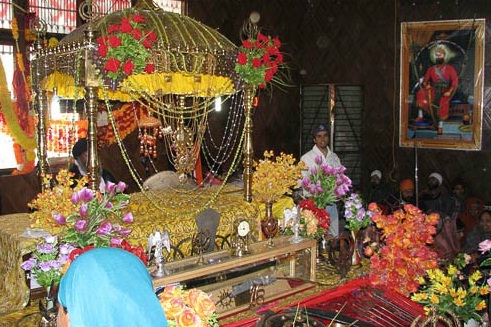"pritham bhagautee simar
kai, Gur Nanak laee dhiaa-e phir Angad gur tay Amardaas, Raamdaasai
hoee sahaee"
Situated 4000 mt above
sea level, Sri Hemkunt Sahib is considered as one of the most holy
pilgrimage shrines for Sikhs. Covered with snow capped mountains,
the Sapt-Sring, seven hills that surround the holy shrine and lake
provides a mesmerizing environment.
With the lake’s shores
covered with snow most of the year, during spring time when snows
melts, the mythical Brahma Kamal blooms amidst the rocks. As one of
sikkhism’s most important shrines, this holy site is considered a
pilgrimage as it is associated with tenth guru of Sikhs, Guru
Gobind Singh and is the best place to perform Sahaj Paath Bhog
Ceremony/Ardas, a formal prayer from the side of a family for the
good health & well being of the family and before embarking on
important journeys.
"maran likhaa-ay
aa-ay nahee rahnaa"…Death is pre-ordained - no one who comes can
remain here.
SGGS Page 153, Line
15
Ardas -
Ardās means a request,
a prayer, petition to the superior authority to support and help
the devotee and ask for continued blessings.
"Waheguru please bless me
in the task that I am about to undertake"
It is performed after
reciting daily Banis (prayers) and after completion of services
like the Paath, kirtan (hymn-singing) program or any other
religious program. As a petition to God, the merciful creator of
the universe, the main benefits of Ardas are:
- It
helps in lowering ego and bringing calmness to a person's mental
state
- It
teaches values of humility, compassion, fearlessness
- It
provides inner strength and energy
- It
elevates spiritual state and builds confidence
As one of most
universal prayers in Sikh religion, Ardas maintains uniqueness
because other than reading or reciting Guru’s prayers, it is an
example of mortal offering up his/her own prayer to Waheguru asking
for forgiveness and guidance.
THREE STAGES OF
ARDAS/PRAYER:
The First Section
of Ardas/Prayer -
| ਅਰਦਾਸ: ੴ
ਵਾਹਿਗੁਰੂ ਜੀ ਕੀ ਫਤਹਿ ॥ ਸ੍ਰੀ ਭਗੌਤੀ ਜੀ ਸਹਾਇ ॥ ਵਾਰ ਸ੍ਰੀ ਭਗੌਤੀ ਜੀ ਕੀ
ਪਾਤਸ਼ਾਹੀ ੧੦॥ |
Ardaas,
Ekh-oonkaar Vaaheguroo jee kee Fat'eh. Sree Bhagautee jee Sahaa-e;
vaar Sree Bhagautee jee kee Paat'shaahee
D'assveen
|
The recitation of
ardas commences with opening stanza of the Var Sri Bhagauti Ji
written by Guru Gobind Singh Ji
The Second Section
of Ardas/Prayer -
The second portion of
Ardas discusses sacrifices made by
various Sikhs throughout
history.
The Third Section
of Ardas/Prayer -
It specifies
–
- Basic purpose of
reciting Ardas
- Asking for forgiveness
for any mistakes made during recitation of any and all
prayers

